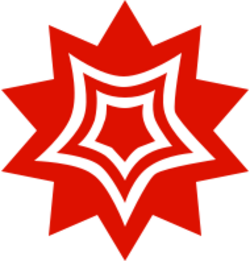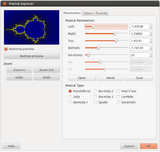Software:Wolfram Mathematica
 | |
| Developer(s) | Wolfram Research |
|---|---|
| Initial release | June 23, 1988[1] |
| Stable release | 14.0.0 (January 9, 2024) [±][2] |
| Written in | Wolfram Language,[3] C/C++, Java[4] |
| Platform | Windows,[5] macOS, Linux (includes separated support for Raspbian on Raspberry Pi[6]), online service. All platforms support 64-bit implementations.[7] (list) |
| Available in | English, Chinese, Japanese |
| Type | Computer algebra, numerical computations, information visualization, statistics, user interface creation |
| License | Proprietary |
| Website | {{{1}}} |
Wolfram Mathematica is a software system with built-in libraries for several areas of technical computing that allow machine learning, statistics, symbolic computation, data manipulation, network analysis, time series analysis, NLP, optimization, plotting functions and various types of data, implementation of algorithms, creation of user interfaces, and interfacing with programs written in other programming languages. It was conceived by Stephen Wolfram, and is developed by Wolfram Research of Champaign, Illinois.[8][9] The Wolfram Language is the programming language used in Mathematica.[10] Mathematica 1.0 was released on June 23, 1988 in Champaign, Illinois and Santa Clara, California.[11][12][13]
Notebook interface
Mathematica is split into two parts: the kernel and the front end. The kernel interprets expressions (Wolfram Language code) and returns result expressions, which can then be displayed by the front end.
The original front end, designed by Theodore Gray[14] in 1988, consists of a notebook interface and allows the creation and editing of notebook documents that can contain code, plaintext, images, and graphics.[15]
Alternatives to the Mathematica front end include Wolfram Workbench—an Eclipse-based integrated development environment (IDE) that was introduced in 2006. It provides project-based code development tools for Mathematica, including revision management, debugging, profiling, and testing.[16]
There is also a plugin for IntelliJ IDEA-based IDEs to work with Wolfram Language code that in addition to syntax highlighting can analyze and auto-complete local variables and defined functions.[17] The Mathematica Kernel also includes a command line front end.[18]
Other interfaces include JMath,[19] based on GNU Readline and WolframScript[20] which runs self-contained Mathematica programs (with arguments) from the UNIX command line.
The file extension for Mathematica files is .nb and .m for configuration files.
Mathematica is designed to be fully stable and backwards compatible with previous versions.
High-performance computing
Capabilities for high-performance computing were extended with the introduction of packed arrays in version 4 (1999)[21] and sparse matrices (version 5, 2003),[22] and by adopting the GNU Multiple Precision Arithmetic Library to evaluate high-precision arithmetic.
Version 5.2 (2005) added automatic multi-threading when computations are performed on multi-core computers.[23] This release included CPU-specific optimized libraries.[24] In addition Mathematica is supported by third party specialist acceleration hardware such as ClearSpeed.[25]
In 2002, gridMathematica was introduced to allow user level parallel programming on heterogeneous clusters and multiprocessor systems[26] and in 2008 parallel computing technology was included in all Mathematica licenses including support for grid technology such as Windows HPC Server 2008, Microsoft Compute Cluster Server and Sun Grid.
Support for CUDA and OpenCL GPU hardware was added in 2010.[27]
Extensions
As of Version 13, there are 6,051 built-in functions and symbols in the Wolfram Language.[28] Stephen Wolfram announced the launch of the Wolfram Function Repository in June 2019 as a way for the public Wolfram community to contribute functionality to the Wolfram Language.[29] At the time of Stephen Wolfram's release announcement for Mathematica 13, there were 2,259 functions contributed as Resource Functions.[30] In addition to the Wolfram Function Repository, there is a Wolfram Data Repository with computable data and the Wolfram Neural Net Repository for machine learning.[31]
Wolfram Mathematica is the basis of the Combinatorica package, which adds discrete mathematics functionality in combinatorics and graph theory to the program.[32]
Connections to other applications, programming languages, and services
Communication with other applications can be done using a protocol called Wolfram Symbolic Transfer Protocol (WSTP). It allows communication between the Wolfram Mathematica kernel and the front end and provides a general interface between the kernel and other applications.[33]
Wolfram Research freely distributes a developer kit for linking applications written in the programming language C to the Mathematica kernel through WSTP using J/Link.,[34] a Java program that can ask Mathematica to perform computations. Similar functionality is achieved with .NET /Link,[35] but with .NET programs instead of Java programs.
Other languages that connect to Mathematica include Haskell,[36] AppleScript,[37] Racket,[38] Visual Basic,[39] Python,[40][41] and Clojure.[42]
Mathematica supports the generation and execution of Modelica models for systems modeling and connects with Wolfram System Modeler.
Links are also available to many third-party software packages and APIs.[43]
Mathematica can also capture real-time data from a variety of sources[44] and can read and write to public blockchains (Bitcoin, Ethereum, and ARK).[45]
It supports import and export of over 220 data, image, video, sound, computer-aided design (CAD), geographic information systems (GIS),[46] document, and biomedical formats.
In 2019, support was added for compiling Wolfram Language code to LLVM.[47]
Version 12.3 of the Wolfram Language added support for Arduino.[48]
Computable data
Mathematica is also integrated with Wolfram Alpha, an online answer engine that provides additional data, some of which is kept updated in real time, for users who use Mathematica with an internet connection. Some of the data sets include astronomical, chemical, geopolitical, language, biomedical, airplane, and weather data, in addition to mathematical data (such as knots and polyhedra).[49]
Reception
BYTE in 1989 listed Mathematica as among the "Distinction" winners of the BYTE Awards, stating that it "is another breakthrough Macintosh application ... it could enable you to absorb the algebra and calculus that seemed impossible to comprehend from a textbook".[50] Mathematica has been criticized for being closed source.[51] Wolfram Research claims keeping Mathematica closed source is central to its business model and the continuity of the software.[52][53]
See also
- Comparison of multi-paradigm programming languages
- Comparison of numerical-analysis software
- Comparison of programming languages
- Comparison of regular expression engines
- Computational X
- Dynamic programming language
- Fourth-generation programming language
- Functional programming
- List of computer algebra systems
- List of computer simulation software
- List of information graphics software
- Literate programming
- Mathematical markup language
- Mathematical software
- WolframAlpha, a web answer engine
- Wolfram Language
- Wolfram SystemModeler, a physical modeling and simulation tool which integrates with Mathematica
- SageMath
References
- ↑ Wolfram, Stephen (23 Jun 2008), Mathematica Turns 20 Today, Wolfram, http://blog.wolfram.com/2008/06/23/mathematica-turns-20-today/, retrieved 16 May 2012
- ↑ "The Story Continues: Announcing Version 14 of Wolfram Language and Mathematica". https://writings.stephenwolfram.com/2024/01/the-story-continues-announcing-version-14-of-wolfram-language-and-mathematica/.
- ↑ "Celebrating Mathematica's First Quarter Century". http://blog.wolfram.com/2013/06/23/celebrating-mathematicas-first-quarter-century/.
- ↑ The Software Engineering of Mathematica—Wolfram Mathematica 9 Documentation . Reference.wolfram.com. Retrieved on 2015-03-23.
- ↑ "Mathematica 12 System Requirements and Platform Availability". https://www.wolfram.com/mathematica/system-requirements.html.
- ↑ Raspberry Pi Includes Mathematica for Free The Verge
- ↑ "Wolfram Mathematica". http://www.wolfram.com/products/mathematica/platforms/.
- ↑ "Stephen Wolfram: Simple Solutions; The iconoclastic physicist's Mathematica software nails complex puzzles". October 3, 2005. https://www.bloomberg.com/news/articles/2005-10-02/stephen-wolfram-simple-solutions.
- ↑ "Contact Wolfram Research". http://www.wolfram.com/company/contact.cgi.
- ↑ "Stephen Wolfram's new programming language: Can he make the world computable?". Slate Magazine. 6 March 2014. http://www.slate.com/articles/technology/bitwise/2014/03/stephen_wolfram_s_new_programming_language_can_he_make_the_world_computable.html.
- ↑ "Mathematica—Three Decades of Contributions, Invention, Discovery, and Education" (in en). https://www.wolfram.com/mathematica/scrapbook/.
- ↑ "Celebrating a Third of a Century of Mathematica, and Looking Forward—Stephen Wolfram Writings" (in en). https://writings.stephenwolfram.com/2021/10/celebrating-a-third-of-a-century-of-mathematica-and-looking-forward/.
- ↑ "There Was a Time before Mathematica…—Stephen Wolfram Writings" (in en). https://writings.stephenwolfram.com/2013/06/there-was-a-time-before-mathematica/.
- ↑ Patent US8407580 Google Patent Search
- ↑ Hayes, Brian (1990-01-01). "Thoughts on Mathematica". Pixel. http://bit-player.org/wp-content/extras/bph-publications/Pixel-1990-01-Hayes-Mathematica.pdf.
- ↑ "Wolfram intros Workbench IDE for Mathematica". Macworld. 21 June 2006. http://www.macworld.com/news/2006/06/21/workbench/index.php.
- ↑ "Mathematica plugin for IntelliJ IDEA". http://mathematicaplugin.halirutan.de/.
- ↑ Using a Text-Based Interface documentation at wolfram.com
- ↑ "JMath: A GNU Readline based frontend for Mathematica". http://robotics.caltech.edu/~radford/jmath/.
- ↑ "Directory listing". https://reference.wolfram.com/language/ref/program/wolframscript.html.
- ↑ Math software packs new power; new programs automate such tedious processes as solving nonlinear differential equations and converting units by Agnes Shanley, Chemical Engineering, March 1, 2002.
- ↑ Mathematica 5.1: additional features make software well-suited for operations research professionals by ManMohan S. Sodhi, OR/MS Today, December 1, 2004.
- ↑ The 21st annual Editors' Choice Awards , Macworld, February 1, 2006.
- ↑ "Mathematica is tuned to take advantage of CPU features when available". https://support.wolfram.com/39353.
- ↑ "ClearSpeed Advance Accelerator Boards Certified by Wolfram Research; Math Coprocessors Enable Mathematica Users to Quadruple Performance.". http://www.thefreelibrary.com/ClearSpeed+Advance(TM)+Accelerator+Boards+Certified+by+Wolfram...-a0147498410.
- ↑ gridMathematica offers parallel computing solution by Dennis Sellers, MacWorld, November 20, 2002.
- ↑ "CUDA and OpenCL support added in Mathematica 8". https://www.wolfram.com/mathematica/new-in-8/cuda-and-opencl-support/.
- ↑ "Launching Version 13.0 of Wolfram Language + Mathematica—Stephen Wolfram Writings" (in en). https://writings.stephenwolfram.com/2021/12/launching-version-13-0-of-wolfram-language-mathematica/.
- ↑ "The Wolfram Function Repository: Launching an Open Platform for Extending the Wolfram Language—Stephen Wolfram Writings" (in en). https://writings.stephenwolfram.com/2019/06/the-wolfram-function-repository-launching-an-open-platform-for-extending-the-wolfram-language/.
- ↑ "Launching Version 13.0 of Wolfram Language + Mathematica—Stephen Wolfram Writings" (in en). https://writings.stephenwolfram.com/2021/12/launching-version-13-0-of-wolfram-language-mathematica/.
- ↑ "Launching the Wolfram Data Repository: Data Publishing that Really Works—Stephen Wolfram Writings" (in en). https://writings.stephenwolfram.com/2017/04/launching-the-wolfram-data-repository-data-publishing-that-really-works/blog.wolfram.com/2017/04/20/launching-the-wolfram-data-repository-data-publishing-that-really-works/.
- ↑ Skiena, Steven (2003). Computational Discrete Mathematics: Combinatorics and Graph Theory with Mathematica. Cambridge University Press.
- ↑ "Wolfram Symbolic Transfer Protocol (WSTP)". https://www.wolfram.com/wstp/.
- ↑ Mathematica 4.2 by Charles Seiter, Macworld, November 1, 2002.
- ↑ .NET/Link : .NET/Link is a toolkit that integrates Mathematica and the Microsoft .NET Framework.
- ↑ "mathlink: Write Mathematica packages in Haskell - Hackage". http://hackage.haskell.org/package/mathlink.
- ↑ S.Kratky. "MathLink for AppleScript". http://www.unisoftwareplus.com/products/mathlinkosax/.
- ↑ "MrMathematica: Calling Mathematica from Scheme". http://www.cs.utah.edu/~czhu/SchemeLink/mrmma.html.
- ↑ "Mathematica for ActiveX - from Wolfram Library Archive". http://library.wolfram.com/infocenter/TechNotes/4710/.
- ↑ "erocarrera/pythonika". GitHub. https://code.google.com/p/pythonika/.
- ↑ "PYML (Python Mathematica interface) - from Wolfram Library Archive". http://library.wolfram.com/infocenter/MathSource/585/.
- ↑ "Clojuratica - Home". Clojuratica.weebly.com. http://clojuratica.weebly.com/.
- ↑ "Wolfram Documentation: ServiceConnect". https://reference.wolfram.com/language/ref/ServiceConnect.html.
- ↑ "Vernier and Mathematica". https://www.vernier.com/news/2017/08/25/vernier-and-mathematica/.
- ↑ "Working with blockchains". https://reference.wolfram.com/language/guide/Blockchain.html.
- ↑ Mathematica 6 Labs Review Cadalyst Feb 1, 2008
- ↑ "Create LLVM code". https://www.wolfram.com/language/12/code-compilation/create-llvm-code.html.
- ↑ "Launching Version 12.3 of Wolfram Language & Mathematica—Stephen Wolfram Writings" (in en). https://writings.stephenwolfram.com/2021/05/launching-version-12-3-of-wolfram-language-mathematica/.
- ↑ "Scientific and Technical Data", Mathematic Guide, Wolfram Research, http://reference.wolfram.com/mathematica/guide/ScientificAndTechnicalData.html, retrieved 16 May 2012
- ↑ "The BYTE Awards". BYTE: 327. January 1989. https://archive.org/stream/byte-magazine-1989-01/1989_01_BYTE_14-01_PC_Communications_and_Annual_Awards_and_Digitizing_Tablets#page/n371/mode/2up.
- ↑ "Paul Romer". https://paulromer.net/jupyter-mathematica-and-the-future-of-the-research-paper/.
- ↑ "Why Wolfram Tech Isn't Open Source—A Dozen Reasons—Wolfram Blog" (in en). https://blog.wolfram.com/2019/04/02/why-wolfram-tech-isnt-open-source-a-dozen-reasons/.
- ↑ "Six Reasons Why the Wolfram Language Is (Like) Open Source—Wolfram Blog" (in en). https://blog.wolfram.com/2021/11/30/six-reasons-why-the-wolfram-language-is-like-open-source/.
External links
- Mathematica Documentation Center
- A little bit of Mathematica history documenting the growth of code base and number of functions over time
 |


